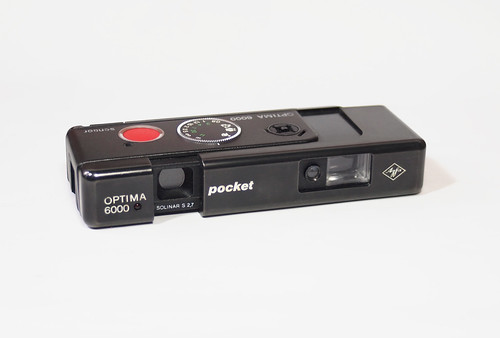 |
| Agfa Optima 6000 Pocket Sensor |
Agfa enthusiastically embraced the 110 format when Kodak introduced the small drop-in cartridge system in 1972, despite not previously manufacturing any 16mm subminiature cameras during the brief period when these had a certain limited popularity. The
Optima 6000 Pocket Sensor was first produced in 1975, by which time Agfa had a fairly large range of 110 format cameras, from the most basic to the relatively sophisticated. It was then Agfa's top-of-the-range model, only bettered the next year by the Agfamatic 6008 Makro Pocket, a revision of the 6000, which featured an additional close-up supplementary lens (Agfa's models ending in '8' had flipflash sockets instead those for the magicube). Most of Agfa's 110 cameras used the 'Agfamatic' name, clearly borrowing from Kodak's
Instamatic, and indeed also taking the 'Pocket' suffix that Kodak also used to distinguish their 110 cameras from the earlier 126 format Instamatics. 'Pocket' obviously trades on the small size of the 110 cameras, though not all 110 cameras were all that pocketable. The Optima 6000 is approximately 13.2x5.6x2.6cm when closed, and its smooth corners and lack of projection make it easier to pocket than some cameras; simpler Agfa 110 cameras were smaller still. The 5000 and 6000 models were clearly thought worth distinguishing from the simpler models by using the
Optima name, borrowed from from Agfa's long-running range of automatic exposure
compact 35mm cameras; the
Sensor in the camera's name also derives from Agfa's unique shutter release, the large, slightly domed orange button, intended to produce a smooth action when pressed, compared to other shutter releases. The Optima 5000 and 6000 models were all black, constructed from plastic, with some metal, notably with the front sliding panel. As with their other models of the 1970s, Agfa's 110 range demonstrate the attention to detail that their design department invested in: there's a good
interview with Julian Schlagheck, the son of one part of Agfa's design team, Schlagheck Schultes Design, about the Agfamatic cameras, which gives a good background into their development.
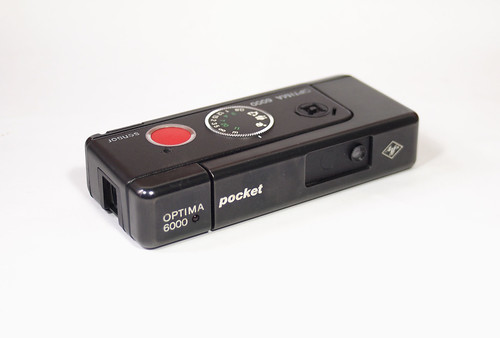 |
| Agfa Optima 6000 Pocket Sensor closed |
The most notable feature of the Optima 6000 that elevates it above many 110 cameras is its fast lens, a Tessar-type Agfa Solinar S f2.7. As a fast lens, it also focusses; many other small format cameras rely on a smaller aperture with a short focal length fixed-focus lens to provide an acceptable depth of field from a relatively close distance. The focal length on the Solinar lens is not marked on the camera: some websites describe it as 26mm, others, 27mm. The focussing dial is located in the middle of the camera's top plate, with a standard set of pictograms (mountain, group, and half-length portrait), which have click-stops, as well as distances in both meters and feet. This has a grip with a toothed edge around it and the distance settings are read against two indicator marks at the top and bottom of the dial. The pictograms are visible in the camera's viewfinder with a red pointer to show the focal setting. The frame-lines inside the viewfinder also have parallax marks. Exposure is automatic, with a CDS cell visible on the front of the camera with the sliding cover open and closed, powered by three 625G batteries, still commonly available. These are located next to the film cartridge chamber, as in the image below. Partially depressing the orange sensor button lights LEDs inside the viewfinder (as well as a red LED on the camera's front), green for an exposure of 1/30th - 1/1000th, with a red LED as a long exposure warning. According to the manual, the camera is capable of exposures as long as 30 seconds, although I haven't found the shutter to stay open for longer than what sounds like a half second, if that, even when operated at night. One curiosity about the camera is that the shutter is in front of the lens, not behind it or between its elements. Next to the orange sensor button is a standard cable release socket, and on the underneath of the camera body is a small switch for a self-timer. The 6000 model was a small evolution of the Optima 5000: the self-timer is one of the improvements, along with the presence of symbols in the viewfinder, and the LED on the front. For using a flash, there is a socket on the top of the body for flashcubes, which rotates with the film advance, as well as a hot shoe on one end of the camera body for Agfa's dedicated 110 flash unit, the Optima Pocket Lux. Although taking the form of a typical hot shoe, this is rotated through 90 degrees, meaning a traditional flash unit would be facing downwards, instead of facing the front. There was an insert for the hot shoe, which my camera lacks, with a screw socket, doubling for use as a tripod mount or to attach a carrying chain; the Optima Pocket Lux has its own tripod socket.
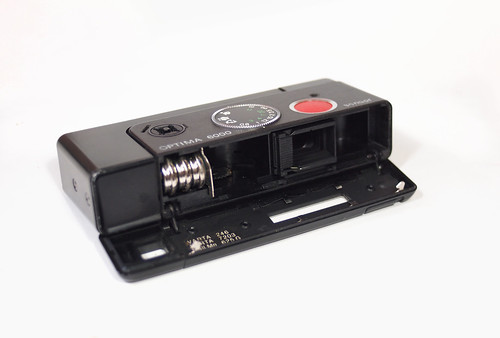 |
| Agfa Optima 6000 Pocket Sensor with back open |
Like many 110 cameras, the Optima 6000 has a push-pull frame advance (which also cocks the shutter) using the sliding cover, a mechanism derived from earlier 16mm cameras, such as the Minolta 16. There is a switch on the underneath of the camera to unlock the sliding cover which springs open; this switch can be moved to the closed position while the camera is still open, and the sliding cover will lock into the closed position when pushed in.
In testing the Agfa Optima 6000 Pocket Sensor I only used with reloaded 110 cassettes, which has both disadvantages and advantages with this particular camera. The Subclub website has a
good page on reloading 110 cassettes, dividing cameras into type A and type B: type A cameras do not need the 110 format perforations on the film to cock the shutter, while type B do require this perforation. In type A cameras it is possible to use unperforated 16mm film; type B cameras need perforations to work. 110 film has one perforation per frame, whereas standard 16mm perforations are around three per 110 frame. In addition 16mm film comes in both single and double perforated. I've previously used reloaded 110 cassettes in a
Pentax Auto 110, a camera which doesn't require perforations to work, and when using single perforated film, I aligned the perforations on the top edge of the film cassette when reloading, meaning that these appear in the
bottom of the image, which seemed more aesthetically pleasing. With the Optima 6000, the camera does require the perforations to work, these perforations needing to be at the bottom of the cassette, and so show at the
top of the image. The Subclub recommends advancing a 'type B' camera four times for each frame, based on the number of perforations. This assumes that the pin will register each perforation, which I found not to be the case. Instead, the Optima 6000 requires advancing
twice per frame: the pin inside camera will prevent the film from advancing a whole frame, but appears not to locate every single perforation hole. Without advancing the camera twice, the images on the frame will overlap, as below.
 |
| Agfa Optima 6000 overlapping test exposures with a single advance for each frame |
In order to advance the film twice, the shutter needs to be tripped a second time, as the film does not advance until the shutter has fired. In practice, I made the second (blank) exposure by placing my thumb over the lens, small enough for this to be done relatively easily, and with the shutter in front of the lens, there is no danger of getting a fingerprint on the lens itself. Using reloaded cassettes with the original backing paper does mean that one can check the frame numbers on the paper itself to ensure that the film is advancing a whole frame at a time. Of course, this is quite unnecessary if shooting original factory loaded 110 cassettes, and not reloading them. One advantage in using reloaded 110 cassettes is that these do not have the preprinted 110 frames, thus providing a larger negative area: the negatives from the Optima 6000 measured roughly 13.6mm by 19.6mm. When using the Lomography Orca film in the past, the printed frames reduced the negative size to 12.7x17mm. Clearly the perforations intrude into the image area; to crop these out would mean losing some of the image at the top and/or the bottom of the frame, but the increased width of the negative would not be affected. In addition, with reloaded 16mm film, edge printing can show in the negative area, although not all 16mm film has printed codes. Inevitably, the reloaded cassettes did have some light leaks, as seen in the images above and below at the top edges of the frames.
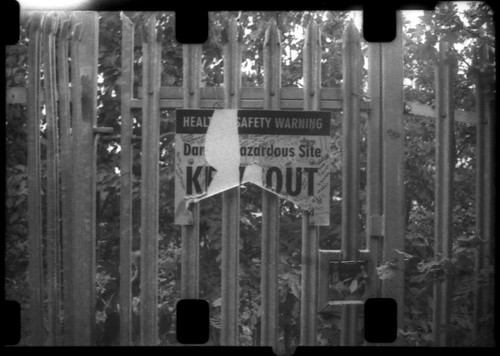 |
| Agfa Optima 6000 Pocket Sensor with Kodak Photo Instrumentation film |
I tested the Optima 6000 with three different 16mm films, two had double perforations, one with single. The Optima 6000 does not have a mechanism to sense the 110 cassette film speed tab, so all the films were shot at the slow speed setting; there's no information as to whether this speed is set at 100 ISO, or 80, or even 64. The best results were probably from a roll of Kodak Special Order
Photo Instrumentation film. Originally 500 ISO, being fifteen years past the date on its box, the results gave a good tonal range and surprisingly low grain for the frame size. All the images on this post were scanned from the negatives; optical printing in a darkroom would have given a finer, sharper image. I also shot some
Eastman Double-X, which was developed as if I'd shot it at an exposure index of 200; the camera would have exposed it at 100. This film I shot in some low-light conditions, to test the camera's fast lens, the results of which were mostly acceptable, as below, unless the available light levels were very low, in which conditions the camera's shutter seems to simply have not stayed open long enough for the exposure required. This might be due to the cameras age, or some other factors.
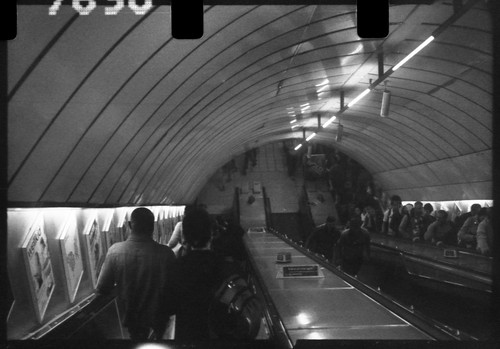 |
| Agfa Optima 6000 Pocket Sensor with Eastman Double-X |
I also shot a cassette loaded with
Eastman 4-X negative film. As Kodak stopped manufacturing this stock around 1990, I knew that the film, originally 400 ISO, would have lost a fair amount of sensitivity with age. As the camera would only expose it at around 100, any further compensation would have to be done in developing, hardly ideal. This, incidentally, is a limitation built into the design of Kodak's 110 cassette system. The shots from this roll were very grainy, with a prominent base level of age-related fog, the camera being unable to increase exposure to give a denser image against that fog.
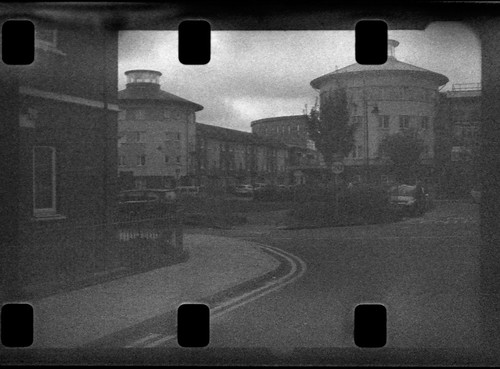 |
| Agfa Optima 6000 Pocket Sensor with Eastman 4-X |
The Optima 6000 Pocket Sensor has all the convenience that the
pocket instamatic format was intended to produce, while clearly being one of the better 110 cameras of the 1970s. The push-pull advance and sensor button are intuitive to use, while the camera body is just weighty enough to inspire some confidence, but not so small as to become difficult, fiddly for larger fingers. The Solinar lens is sharper than my scanning the negatives would disclose: as above, printing from the negatives would be a better assessment of this. The main issues that I had with the camera, apart from the performance in very low light that I've already mentioned, were to do with focus for some shots, in which I assumed that the lens would give greater depth of field than it did, and this would excuse a lack of accuracy in setting the focus dial correctly. The camera does not display what settings its automatic exposure has selected, and as I didn't shoot any of the images on bright, sunny days, it would have been safe to predict that the exposures generally required wider apertures. Using reloaded film, I also did not always remember to advance
twice per frame; this issue wouldn't occur with new 110 film.
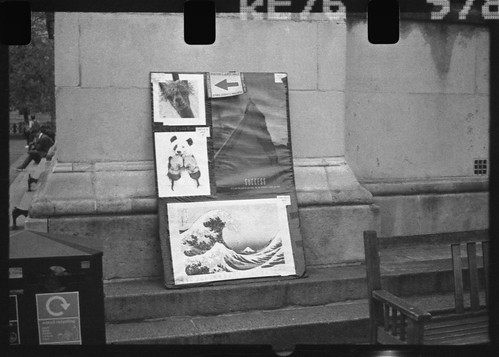 |
| Agfa Optima 6000 Pocket Sensor with Eastman Double-X |
 |
| Agfa Optima 6000 Pocket Sensor with Eastman Double-X |
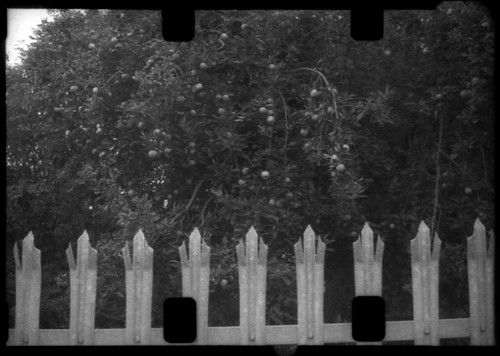 |
| Agfa Optima Pocket Sensor with Kodak Photo Instrumentation film |
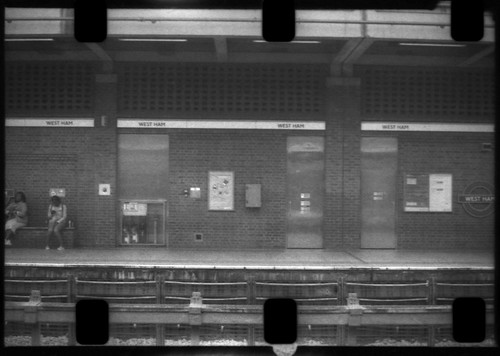 |
| Agfa Optima 6000 Pocket Sensor with Kodak Photo Instrumentation film |
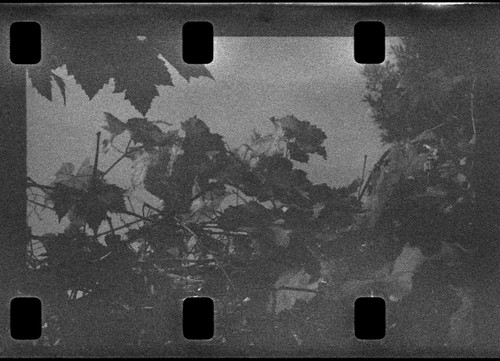 |
| Agfa Optima 6000 Pocket Sensor with Eastman 4-X negative film |
Sources/further information
Agfa Optima 6000 Pocket Sensor on Camera-wiki
Agfa Optima 6000 Pocket Sensor manual: Submin.com (German/Dutch/French/Italian)
Collection-Appareils - Agfa Optima 6000 Pocket Sensor (French)
Agfa Optima 6000 Pocket Sensor on Lippisches-kameramuseum.de (in German)
Agfa 110 camera series
Reloading 110 cassettes - Subclub












No comments:
Post a Comment